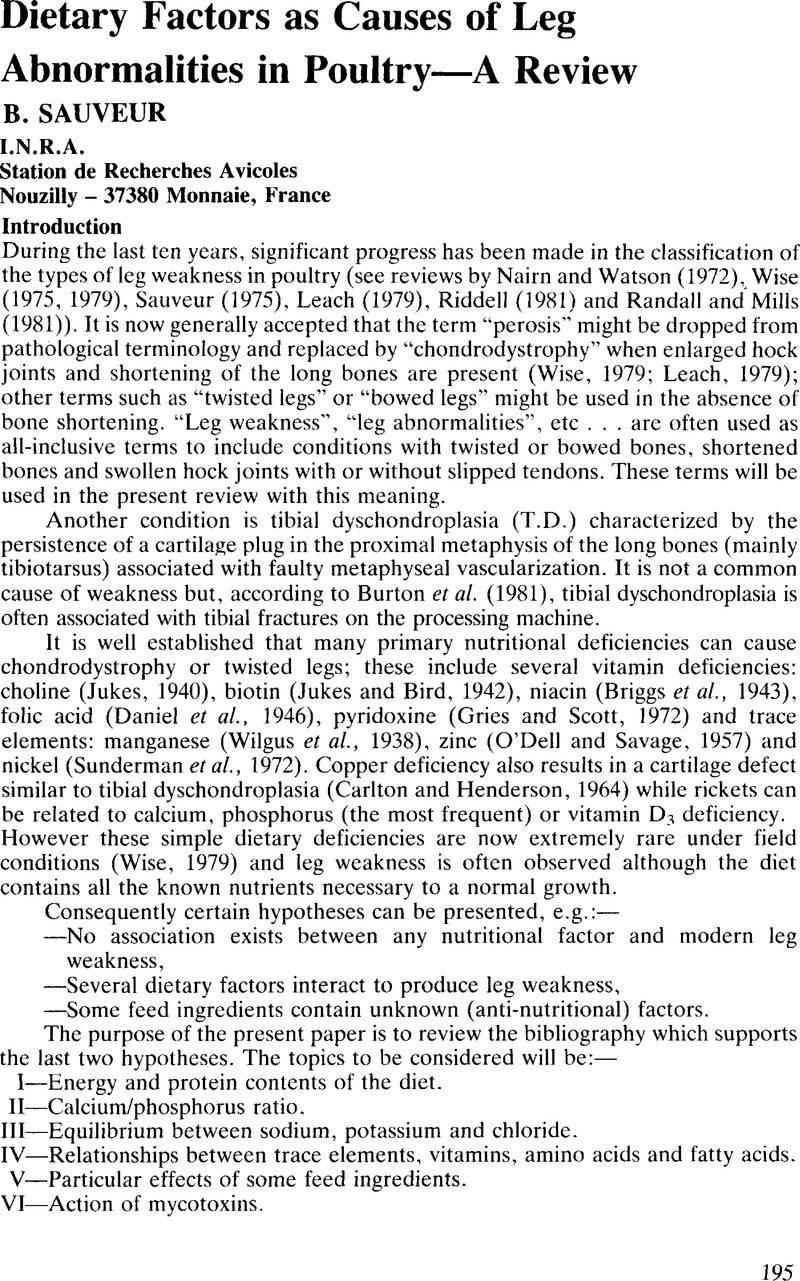Crossref Citations
This article has been cited by the following publications. This list is generated based on data provided by Crossref.
EDWARDS, HARDY M.
1985.
Observations on Several Factors Influencing the Incidence of Tibial Dyschondroplasia in Broiler Chickens.
Poultry Science,
Vol. 64,
Issue. 12,
p.
2325.
Edwards, Hardy M.
1987.
Effects of Thiuram, Disulfiram and a Trace Element Mixture on the Incidence of Tibial Dyschondroplasia in Chickens.
The Journal of Nutrition,
Vol. 117,
Issue. 5,
p.
964.
Leeson, S.
and
Summers, J.D.
1988.
Some nutritional implications of leg problems with poultry.
British Veterinary Journal,
Vol. 144,
Issue. 1,
p.
81.
PATIENCE, J.F.
1989.
Recent Advances in Animal Nutrition.
p.
211.
Warren, B.E.
and
Farrell, D.J.
1990.
The nutritive value of full-fat and defatted Australian rice bran. IV. Egg production of hens on diets with defatted rice bran.
Animal Feed Science and Technology,
Vol. 27,
Issue. 3,
p.
259.
Watkins, B. A.
Whitehead, C. C.
and
Duff, S. R. I.
1991.
Hydrogenated oil decreases tissue concentrations of n‐6 polyunsaturated fatty acids and may contribute to dyschondroplasia in broilers.
British Poultry Science,
Vol. 32,
Issue. 5,
p.
1109.
PINES, M.
and
HURWITZ, S.
1991.
The Role of the Growth Plate in Longitudinal Bone Growth.
Poultry Science,
Vol. 70,
Issue. 8,
p.
1806.
Solfrizzo, Michele
Strange, Richard N.
Sabia, Cinzia
and
Visconti, Angelo
1994.
Production of a toxin stemphol by Stemphylium species.
Natural Toxins,
Vol. 2,
Issue. 1,
p.
14.
FRANKEL, T.L.
1995.
Sulfate Incorporation into Organic Bone Matrix of the Tibiotarsus of Broiler Chicks is Reduced by Excess Dietary Methionine.
Poultry Science,
Vol. 74,
Issue. 3,
p.
510.
Edwards, H.M.
2000.
Nutrition and Skeletal Problems in Poultry.
Poultry Science,
Vol. 79,
Issue. 7,
p.
1018.
Nascimento, J.A.F.B.
Nunes, V.A.
Guedes, R.M.C.
and
Rachid, M.A.
2001.
Toxina T-2 e alterações do crescimento endocondral em frangos de corte.
Arquivo Brasileiro de Medicina Veterinária e Zootecnia,
Vol. 53,
Issue. 3,
p.
332.
Vieites, Flávio Medeiros
Moraes, George Henrique Kling de
Albino, Luiz Fernando Teixeira
Rostagno, Horacio Santiago
Rodrigues, Ana Cláudia
Silva, Fernanda Álvares da
and
Atencio, Anel
2004.
Balanço eletrolítico e níveis de proteína bruta sobre parâmetros sangüíneos e ósseos de frangos de corte aos 21 dias de idade.
Revista Brasileira de Zootecnia,
Vol. 33,
Issue. 6,
p.
1520.
Pines, M.
Hasdai, A.
and
Monsonego-Ornan, E.
2005.
Tibial dyschondroplasia – tools, new insights and future prospects.
World's Poultry Science Journal,
Vol. 61,
Issue. 2,
p.
285.
Yalçin, S.
Molayoglu, H.B.
Baka, M.
Genin, O.
and
Pines, M.
2007.
Effect of Temperature During the Incubation Period on Tibial Growth Plate Chondrocyte Differentiation and the Incidence of Tibial Dyschondroplasia.
Poultry Science,
Vol. 86,
Issue. 8,
p.
1772.
Araújo, G.M.
Vieites, F.M.
Barbosa, A.A.
Caramori Junior, J.G.
Santos, A.L.
Moraes, G.H.K.
Abreu, J.G.
and
Muller, E.S.
2011.
Variação aniônica da dieta sobre características ósseas de frangos de corte: resistência à quebra, composição orgânica e mineral.
Arquivo Brasileiro de Medicina Veterinária e Zootecnia,
Vol. 63,
Issue. 4,
p.
954.
Araújo, Gilson Mendes
Silva, José Humberto Vilar da
Vieites, Flávio Medeiros
Moraes, George Henrique Kling de
Souza, Rafael Barbosa de
Barbosa, Anderson de Almeida
and
Caramori Junior, João Garcia
2012.
Anionic variation of diets on bone characteristics of broilers at 7 and 14 days of age.
Revista Brasileira de Zootecnia,
Vol. 41,
Issue. 9,
p.
2124.
Ghosh, A.
Mandal, G.P.
Roy, A.
and
Patra, A.K.
2016.
Effects of supplementation of manganese with or without phytase on growth performance, carcass traits, muscle and tibia composition, and immunity in broiler chickens.
Livestock Science,
Vol. 191,
Issue. ,
p.
80.
Saldanha, Mariana M.
Araújo, Itallo C.S.
Triguineli, Marcela V.
Vaz, Diego P.
Ferreira, Felipe N.A.
Albergaria, Juliano D.S.
Fontes, Dalton O.
and
Lara, Leonardo J.C.
2020.
Relative bioavailability of manganese in relation to proteinate and sulfate sources for broiler chickens from one to 20 d of age.
Poultry Science,
Vol. 99,
Issue. 11,
p.
5647.
Cruvinel, Jessica Moraes
Urayama, Priscila Michelin Groff
dos Santos, Tatiane Souza
Denadai, Juliana Célia
Muro, Everton Moreno
Dornelas, Livia Carrasco
Pasquali, Guilherme Aguiar Mateus
Neto, Armando Carlos Contin
Zanetti, Leonardo Henrique
Netto, Raiumundo Gonçalves Ferreira
Sartori, José Roberto
and
Pezzato, Antonio Celso
2021.
Different dietary electrolyte balance values on performance, egg, and bone quality of Japanese quail (Coturnix Coturnix Japonica) under heat stress.
Tropical Animal Health and Production,
Vol. 53,
Issue. 1,



